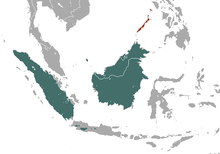Stink badger
| Stink badgers[1] | |
|---|---|
.jpg) | |
| M. javanensis | |
| Scientific classification | |
| Kingdom: | Animalia |
| Phylum: | Chordata |
| Class: | Mammalia |
| Order: | Carnivora |
| Family: | Mephitidae |
| Genus: | Mydaus Cuvier, 1821 |
| Species | |
 | |
| Mydaus ranges | |

Stink badgers (Mydaus) are not true badgers but a genus of the skunk family of carnivorans, the Mephitidae. There are only two extant species - the Palawan stink badger (M. marchei), and the Sunda stink badger or Teledu (M. javanensis). They live only on western islands of the Malay Archipelago: Sumatra, Java, Borneo and (in the case of the Palawan stink badger) on the Philippine island of Palawan; as well as many other, smaller islands in the region.
Stink badgers are named for their resemblance to badgers and for the foul-smelling secretions that they expel from anal glands in self-defense (which is stronger in the Sunda species).[2]
Stink badgers were traditionally thought to be related to true badgers in the (subfamily Melinae) of the weasel family of carnivores, the Mustelidae, but recent DNA analysis so strongly suggests they share a more recent common ancestor with skunks that experts have now placed them in the skunk family of carnivores, the Mephitidae.[2][3] The two existing species are different enough from each other for the Palawan stink badger to be sometimes classified in its own genus, Suillotaxus.[2]
References
- ↑ Wozencraft, W.C. (2005). "Order Carnivora". In Wilson, D.E.; Reeder, D.M. Mammal Species of the World: A Taxonomic and Geographic Reference (3rd ed.). Johns Hopkins University Press. pp. 622–623. ISBN 978-0-8018-8221-0. OCLC 62265494.
- 1 2 3 Stink badgers at the Badger Pages
- ↑ Koepfli KP, Deere KA, Slater GJ, et al. (2008). "Multigene phylogeny of the Mustelidae: resolving relationships, tempo and biogeographic history of a mammalian adaptive radiation". BMC Biol. 6 (1): 4–5. doi:10.1186/1741-7007-6-10. PMC 2276185
 . PMID 18275614.
. PMID 18275614.